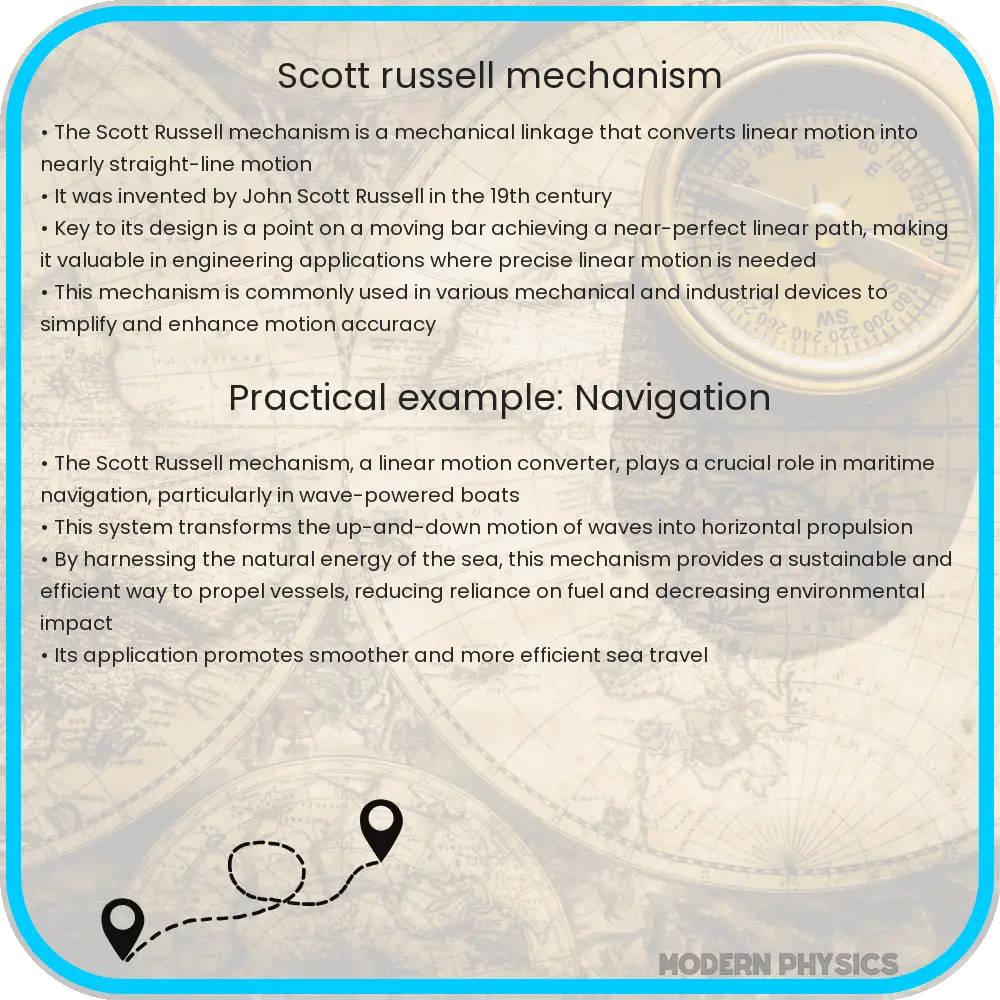Explore the Scott Russell Mechanism’s efficiency, straight-line motion, design impact, and modern enhancements in mechanical engineering.

Understanding the Scott Russell Mechanism: Unveiling the Principles of Efficiency, Motion, and Design
The Scott Russell mechanism, a marvel of mechanical engineering, epitomizes the elegant integration of simplicity and functionality. It is a mechanism that converts linear motion into near-perfect straight-line motion, a principle widely utilized in various engineering and technological applications. This article delves into the core aspects of the Scott Russell mechanism, exploring its efficiency, motion characteristics, and design implications.
Efficiency in the Scott Russell Mechanism
At its core, the Scott Russell mechanism is valued for its efficiency. Efficiency, in mechanical terms, refers to the effective conversion of input energy into desired motion or output with minimal loss. The Scott Russell mechanism achieves this through its unique design, which minimizes friction and wear. The reduced number of moving parts compared to other motion-converting mechanisms significantly lowers the energy dissipation, making it an ideal choice for applications where energy conservation is paramount.
Motion Characteristics of the Scott Russell Mechanism
The most distinguished feature of the Scott Russell mechanism is its ability to produce a nearly perfect straight line. This is achieved through a clever arrangement of pivots and links. When one end of the mechanism undergoes a circular motion, the other end traces a straight path. This characteristic is particularly advantageous in applications where precision and accuracy of linear motion are critical, such as in the guidance systems of CNC machines or in optical instruments.
Design Implications and Applications
The design of the Scott Russell mechanism is a testament to the power of mechanical simplicity. Its compact and straightforward structure not only makes it easy to manufacture and maintain but also allows for its integration into a wide range of machinery and devices. This mechanism finds its applications in areas as diverse as automotive suspension systems, where it aids in shock absorption, to artistic installations, where its motion creates visually captivating effects.
Furthermore, the adaptability of the Scott Russell mechanism in modern engineering underscores its relevance. With advancements in materials science and technology, there are new possibilities for enhancing its performance and expanding its applications. For instance, using lightweight, high-strength materials can further improve its efficiency and durability, making it more suitable for high-performance and demanding environments.
Enhancing the Scott Russell Mechanism with Modern Technology
In the era of technological advancement, the potential to enhance the Scott Russell mechanism is significant. Innovations in computer-aided design (CAD) and simulation tools enable engineers to optimize the mechanism’s design with unprecedented precision. These tools can simulate various load conditions and material properties, ensuring that the mechanism can operate efficiently under diverse circumstances. Additionally, the integration of smart sensors and actuators opens up possibilities for creating adaptive systems that can dynamically adjust the motion characteristics of the mechanism in real-time, enhancing both its efficiency and functionality.
Environmental and Economic Impact
The environmental and economic implications of the Scott Russell mechanism are noteworthy. By optimizing energy use and reducing material wastage, this mechanism contributes to more sustainable engineering solutions. Its durability and low maintenance requirements also make it economically advantageous, reducing the lifecycle cost of products and systems in which it is integrated. These attributes align well with the global push towards more sustainable and eco-friendly engineering practices.
Educational and Research Prospects
The Scott Russell mechanism is not just a tool for current engineers and designers but also serves as an invaluable educational resource. Its simplicity and effectiveness make it an ideal subject for study in mechanical engineering courses, offering students a clear example of kinematic theory in practice. Moreover, ongoing research into this mechanism, especially in the fields of materials science and robotics, continues to reveal new potentials and applications, keeping it at the forefront of mechanical engineering innovation.
Conclusion
The Scott Russell mechanism stands as a beacon of mechanical ingenuity, demonstrating how simple concepts can lead to significant advancements in efficiency, precision, and design. Its ability to convert motion with minimal energy loss and its adaptability across various applications make it a cornerstone in the field of mechanical engineering. As we continue to innovate and push the boundaries of technology, the principles embodied in the Scott Russell mechanism will undoubtedly play a pivotal role in shaping future engineering solutions. Its ongoing evolution and adaptation in response to modern technological advancements and environmental considerations highlight its enduring relevance and potential in an ever-changing world.
